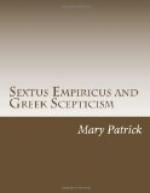The picture on the other hand, presented to us by Sextus and Tertullian, is that of a man with a system of beliefs and dogmas, which lead, he says, to the philosophy of Heraclitus. In strange contradiction to his assertion of the impossibility of all knowledge, he advocates a theory that the original substance is air,[1] which is most certainly a dogma, although indeed a deviation from the teachings of Heraclitus, of which Sextus seemed unconscious, as he says, [Greek: to te on kata ton Herakleiton aer estin, hos physin ho Ainesidemos]. Aenesidemus dogmatised also regarding number and time and unity of the original world-stuff.[2] He seems to have dogmatised further about motion,[3] and about the soul.[4]
If Sextus’ language is taken according to its apparent meaning, we find ourselves here in the presence of a system of beliefs which would be naturally held by a follower of the Stoic-Heraclitan physics,[5] and absolutely inexplicable from the standpoint of a man who advocated so radical a Scepticism as Aenesidemus. Sextus in the passage that we first quoted,[6] expresses great indignation against the idea that Scepticism could form the path to the philosophy of Heraclitus, but he does not express surprise or indignation against Aenesidemus personally, or offer any explanation of the apparent contradiction; and while his writings abound in references to him as a respected leader of the Sceptical School, he sometimes seems to include him with the Dogmatics, mentioning him with the [Greek: dogmatikon philosophon].[7] In fact, the task of presenting any consistent history of the development of thought through which Aenesidemus passed is such a puzzling one, that Brochard brilliantly remarks that possibly the best attitude to take towards it would be to follow the advice of Aenesidemus himself, and suspend one’s judgment altogether regarding it. Is it possible to suppose that so sharp and subtle a thinker as Aenesidemus held at the same time such opposing opinions?
[1] Adv. Math. X. 233.
[2] Adv. Math. IX. 337; X. 216.
[3] Adv. Math. X. 38.
[4] Adv. Math. VII. 349.
[5] Compare Zeller Op. cit. III. p. 33.
[6] Hyp. I. 210-212.
[7] Adv. Math. VIII. 8; X. 215.
The conjecture that he was first a Heraclitan Stoic, and later a Sceptic, which might be possible, does not offer any explanation of Sextus’ statement, that he regarded Scepticism as a path to the philosophy of Heraclitus. Nor would it be logical to think that after establishing the Sceptical School in renewed influence and power, he reverted to the Heraclitan theories as they were modified by the Stoics. These same theories were the cause of his separation from the Academy, for his chief accusation against the Academy was that it was adopting the dogmatism of the Stoics.[1] The matter is complicated by the fact that Tertullian also attributes to Aenesidemus anthropological and physical teachings that agree with the Stoical Heraclitan doctrines. It is not strange that in view of these contradictory assertions in regard to the same man, some have suggested the possibility that they referred to two different men of the same name, a supposition, however, that no one has been able to authoritatively vindicate.




